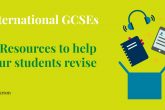
It’s time to reconsider our approach so that we’re setting up language learners for a more supported entrance into English literacy, and a more successful and enjoyable journey to being a reader.
Earlier isn’t always better
International schools, like many others, are often predisposed to introducing literacy at earlier and earlier ages. The reasons for this vary, but often it comes down to parental pressure. There is an ongoing tendency to believe that ‘earlier is better’ for many things in education. We know from research that this is not the case for literacy. The ideal age for most children to learn to read and write is between the ages of 6-7 years. It is at this point than most children are cognitively ready for the task of becoming literate. We also know that there is a strong relationship between attitude towards reading and academic success, which means the more we help kids love reading, the better off they are for the rest of their school years.
It is hard, in any circumstances, to encourage children to love to read when it is difficult and unrewarding. This is a main issue with early literacy; waiting until children are ready means that it will be easier, and more likely to be a pleasant experience. Pushing children into literacy when they are not ready, conversely, is likely to make them experience literacy in negative ways, and to experience feelings of failure.
What about children in international schools, who are learning the language of instruction (generally English) while learning English?
The basic skills of literacy in English are an understanding of the phonetics of English (the sounds) and knowledge of vocabulary. Trying to read in the absence of these is obviously a very difficult task. Schools use literacy resources that have been developed for native speakers, which are based on these key basic skills of phonetics and word knowledge. Many words in English ‘early readers’ are actually very complex and can’t be sounded out, but this is the only tool that language learner children bring to the task, because they just don’t know the words. Imagine learning to read in English with a phonics approach, and then encountering books filled with words like ‘the’, ‘said’, ‘comes’ and ‘one’, carefully learning all the phonics, only to discover that so many of the words break the rules!
It seems obvious then to allow children time to learn English first, before teaching them to read and write. There are many stages to literacy, and focusing on appropriate stages for the age and level of language development of children will naturally lead to a more successful and enjoyable journey to being a reader and writer. I particularly like the simple framework in ‘Before They Read’,¹ which is based on the building blocks of literacy: classroom environment; conversations; read-alouds; and phonological awareness. The first three help develop both the sounds of English and vocabulary, and once these essentials are underway, a clear focus on phonetics/phonics is introduced as pre-literacy. Developing this framework across the preschool and kindergarten years will set language learners up for a more supported entrance into English literacy. Being given 1-3 years to just learn English will make becoming literate more enjoyable and more meaningful for language learner students.
So let’s all take a step back and reconsider the right time and the right way to approach literacy in international schools, especially with our language learner students. Providing them with a well-supported, well-scaffolded, well-timed journey to literacy will set them off on a path to being successful, enthusiastic readers.
References
1 Puett Miller, C. (2010). Before They Read.Gainsville : Maupin House.
About the author
Eowyn Crisfield is a Canadian-educated specialist in bilingualism, bilingualism in education, and teacher-training. She holds a B.Ed. in Teaching English as a Second/Foreign Language, and a Master of Arts in Applied Linguistics, with specialisations in language learning and teaching, and bilingual education. Eowyn has over 20 years of experience in the field of Applied Linguistics, and has a background that covers research, teaching and teacher-training, and supporting bilingual families. She is currently an Associate Lecturer at Oxford Brookes University, lecturing on the Post-Graduate Certificate in Teaching Multilingual Learners and the MA TESOL.
Looking for more?
Cornerstone and Keystone Facebook Group is a global community designed for primary and secondary English teachers with a common interest in accelerating English proficiency and preparing children for academic success. The group is based on the the Pearson Cornerstone and Keystone programme – a six level intense primary course for reading and language development. The group is an open group for teachers as a discussion and ideas forum for teachers to share and converse with each other.

